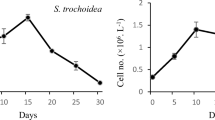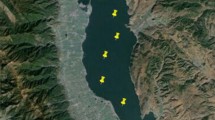Abstract
Red macroalgae from the genus Gracilaria (agarophytes) are of ecological and pharmaceutical importance particularly for agar production. In this study, the red, agarophyte alga Gracilaria corticata was investigated for fluctuations of main and accessory pigments and total carotenoids at two depths during its growing season. The alga was sampled from coastal waters in Brice coast, Chabahar, southern Iran, from December to March in shallow (2–3 m) and higher (5–6 m) depths. The accessory pigments (phycoerythrin, phycocyanin and alophycocyanin), chlorophyll a, and total carotenoids were extracted three times using appropriate solvents and estimated through spectroscopy (mg g−1 dry weight). All pigments of G. corticata increased with depth showing significant differences between the two depths (p < 0.05). Phycoerythrin and phycocyanin were utmost at a depth of 5–6 m in December and January. The highest allophycocyanin and chlorophyll a contents were found at a depth of 5–6 m in February, and total carotenoids were of greatest values at depths of 2–3 m and 5–6 m in March and February, respectively (p < 0.05). The pigment ratios (phycobilin/chlorophyll and total carotenoids/chlorophyll a) at the two depths displayed marked monthly variations (p < 0.05). The greatest phycobilin/chlorophyll a (0.4 ± 0.2418) was found in December (5–6 m) and the ratio of carotenoids/chlorophyll a (0.31 ± 0.0058) was highest in March (2–3 m). The remarkable increases in major and accessory pigments with depth could indicate maximum biomass and production of G. corticata, especially in the months of February and March, which is important for field harvesting operations.





Similar content being viewed by others
References
Abidizadegan M, Khalesi MK, Ajdari D (2016) Depth-dependency of the agarophyte red alga Gracilaria Corticata J. Agardh for agar yield and quality during its growing season. J. Aquacul. Engin. Fish Res 2(2):76–84
Aguilera J, Bischof K, Karsten U et al (2002) Seasonal variation in the ecophysiological patterns in macroalgae from an artic fjord. II. Pigment accumulation and biochemical defence system against high light stress. Mar Biol 140:1087–1095
Arasaki S, Arasaki T (1981) Vegetables from the sea (low calorie, high nutrition. To help you look and feel better). 1st ed. Japan pub., Tokyo
Bansemir A, Blume M, Schroder S et al (2006) Screening of cultivated seaweeds for antibacterial activity against fish pathogenic bacteria. Aquaculture 252(1):79–84. https://doi.org/10.1016/j.aquaculture.2005.11.051
Cabello-Pasini A, Aguirre-Von-Wobeser E, Figueroa F (2000) Photoinhibition of photosynthesis in Macrosystis pyrifera (Phaeophyceae), Chondrus Crispus (Rodophyceae) and Ulva lactuca (Chlorophyceae) in outdoor culture systems. J Photochem Photobiol B 57(2-3):169–178. https://doi.org/10.1016/S1011-1344(00)00095-6
Cardozo KHM, Carvalho VM, Pinto E, Colepicolo P (2006) Fragmentation of mycosporine-like amino acids by hydrogen/deuterium exchange and electrospray ionization tandem mass spectrometry. Rapid Commun Mass Spectrom 20(2):253–258. https://doi.org/10.1002/rcm.2305
Christaki E, Bonos E, Giannenas L et al (2012) Functional properties of carotenoids originating from algae. J Sci Food Agric 93(1):5–11
Dawes C (1981) Marine Botany. Wiley, New York, 628 pp
Derakhshesh B, Yousefzadi M, Afsharnasab M, Yeganeh V, Dashtuiannasab A (2011) In vitro antibacterial activities of the marine macroalgae (Laurencia snvderiae) and (Sargassum angustifolium) against human pathogens (Persian). Iran South Med J 14(1):17–22
Dere S, Dalkiran N, Karacaoglu D et al (2003) The determination of total protein, total soluble carbohydrate and pigment contents of soms macroalgae collected from Gemlik-Karacaali (Bursa) and Erdek-Ormanli (Balikesir) in the sea of Marmara, Turkey. Oceanologia 43(3):453–471
Dring MJ (1990). Light harvesting and pigment composition in marine phytoplankton and macroalgae. In: P.J. Hrrring, A.K. Campbell, M. Whitfield and L. Maddock (eds) Light and life in the sea, Camb. Univ. Press, pp.89–103
Evans LV (1988) The effects of spectral composition and irradiance level on pigment levels in seaweed. In: Lobban CS, Chapman DJ, Kremer BP (eds) In: Experimental phycology: A Laboratory Manual. Cambridge University Press, Cambridge, pp 123–134
Glazer AN (1989) Light guides. Directional energy transfer in a photosynthetic antenna. J Biol Chem 264(1):1–4
Gómez I, Lopez-Figueroa F, Ulloa N et al (2004) Patterns of photosynthesis in 18 species of intertidal macroalgae from southern Chile. Mar Ecol Prog Ser 270:103–116. https://doi.org/10.3354/meps270103
Gómez I, Lopez-Figueroa F, Huovinen P et al (2005) Photosynthesis of the red alga Gracilaria chilensis under natural solar radiation in an estuary in southern Chile. Aquaculture 244(1-4):369–382. https://doi.org/10.1016/j.aquaculture.2004.11.037
Guaratini T, Cardozo KHM, Pinto E et al (2009) Comparison of diode array and electrochemical detection in the C30 reverse phase HPLC analysis of algae carotenoids. J Braz Chem Soc 9:1609–1616
Hosikian A, Lim S, Halim R, Danquah MK (2010) Chlorophyll extraction from microalgae: a review on the process engineering aspects. Int J Chem Eng 2010:1–12. https://doi.org/10.1155/2010/391632
Humphrey AM (1980) Chlorophyll. Food Chem 5(1):57–67. https://doi.org/10.1016/0308-8146(80)90064-3
Jeffrey SW, Humphrey GF (1975) New spectrophotometric equation determining chlorophyll a, b, c2. Biochem Physiol Pflanz 167:194–204
Kain JM, Destombe C (1995) A review of the life history, reproduction and phenology of Gracilaria. J Appl Phycol 7:269–281
Kawsar MA, Fujii Y, Matsumoto R et al (2011) Protein R-phycoerythrin from marine red alga Amphiroa anceps: extraction, purification and characterization. Phytol Bal 17(3):347–354
Lapointe B (1981) The effects of light and nitrogen on growth, pigment content, and biochemical composition of Gracilaria foliifera v. agustissima (Giagartinales, Rhoaophyta). J Phycol 17(1):90–95. https://doi.org/10.1111/j.1529-8817.1981.tb00823.x
Lapointe BE, Duke CS (1984) Biochemical strategies for growth of Gracilaria tikvahiae (Rhodophyta) in relation to light intensity and nitrogen availability. J Phycol 20(4):488–495. https://doi.org/10.1111/j.0022-3646.1984.00488.x
Levy I, Friedlander M (1990) Strain selection in Gracilaria spp. growth, pigment and carbohydrates characterization of straind of Graciliria conferta and G.verrucosa (Rhodophyta, Gigartinales). Bot Mar 33:339–345
Malta M, Rijstenbil JW, Brouwer PEM et al (2003) Vertical heterogeneity in physiological characteristics of Ulva spp. mats. Mar Biol 143(5):1029–1038. https://doi.org/10.1007/s00227-003-1134-4
Marin N, Morales F, Lodeiros C et al (1998) Effect of nitrate concentration on growth and pigment synthesis of Dunaliella salina cultivated under low illumination and preadapted to different salinities. J Appl Phycol 10(4):405–411. https://doi.org/10.1023/A:1008017928651
Marinho-Soriano E (2012) Effect of depth on growth and pigment contents of the macroalgae Gracilaria bursa-pastoris. Brazil J Pharmacog 22(4):730–735. https://doi.org/10.1590/S0102-695X2012005000059
Marinho-Soriano E, Nunes SO, Carneiro MAA, Pereira DC (2009) Nutrients removal from aquaculture wastewater using the macroalgae Gracilaria birdiae. Biomass Bioenergy 33(2):327–331. https://doi.org/10.1016/j.biombioe.2008.07.002
Marquardt R, Hendrik Schubert H, Varela DA et al (2010) Light acclimation strategies of three commercially important red algal species. Aquaculture 299(1-4):140–148. https://doi.org/10.1016/j.aquaculture.2009.11.004
Neori A, Chopin T, Troell M et al (2004) Integrated aquaculture: rationale, evolution and state of the art emphasizing seaweed biofiltration in modern aquacualture. Aquaculture 231:362–391
Paerl H (1984) Cyanobacterial carotenoids: their roles in maintaining optimal photosynthetic production among aquatic bloom forming genera. Oecologia 61(2):143–149. https://doi.org/10.1007/BF00396752
Pereira H, Barreira L, Figueiredo F, Custódio L, Vizetto-Duarte C, Polo C, Rešek E, Engelen A, Varela J (2012a) Polyunsaturated fatty acids of marine macroalgae: potential for nutritional and pharmaceutical application. Mar Drugs 10(12):1920–1935. https://doi.org/10.3390/md10091920
Pereira DC, Trigueria TG, Colepicolo P et al (2012b) Seasonal changes in the pigment composition of natural population of Gracilaria domingensis (Gracilariales, Rhodophyta). Rev Bras 22(4):874–880. https://doi.org/10.1590/S0102-695X2012005000075
Pinto E, Nieuwerburgh LV, Barros MP et al (2003) Density-dependent patterns of thiamine and pigments in production in Nitzschia microcephala. Phytochemistry 63(2):155–163. https://doi.org/10.1016/S0031-9422(03)00048-7
Porra RJ, Thompson WA, Kriedermann PE (1989) Determination of accurate extinction coefficients and simultaneous equations for assaying chlorophylls a and b extracted with four different solvents: verification of the concentration of chlorophyll standards by atomic absorption spectroscopy. Biochim Biophys Acta 975:384–394
Qaranjik MB, Rohani Ghadikolaei K (2011) Atlas of the algae of the Persian Gulf and Oman Sea coasts. 1st edn. Iran Fish Res Organ pp 170
Qaranjik BM, Wynne M, Bangmei X et al (2011) The biomass of the medicinal red algae (Rhodophyta) in the intertidal zone of the Chabahar coasts. Iran Fish Sci Res J 20:103–114
Rabiei R, Asadi M, Sohrabipour J (1989) Morphological and anatomical study of Gracilaria salicornia (C. Agardh) Dawson (Gracilariaceae-Rhodophyta) in the Persian Gulf seahores (Qeshm island). Pajouhesh Sazandegi 75:47–53 In Persian
Rafiei F, Fatemi MR, Filizadeh Y et al (2006) Environmental factors affecting agar extraction from Gracilaria corticata in the coastal areas of Persian gulf, Bandar-e-Lengeh. Iran Sci Fish J 15(1):81–88
Ramus J, Beale SI, Mauzerall D, Howard KL (1976) Changes in photosynthetic pigment concentration in seaweed as a function of water depth. Mar Biol 37(3):223–229. https://doi.org/10.1007/BF00387607
Razi Parjikolaei B, Kloster L, Bruhn A et al (2013) Effect of light quality and nitrogen availability on the biomass production and pigment content of Palmaria palmata (Rhodophyta). Chem Eng Trans 32:967–972
Redlinger T, Gantt E (1982) A M(r) 95,000 polypeptide porphyridium cruentum phycobilisomes and thylakoids: possible function in linkage of phycobilisomes to thylakoids and in energy transfer. Proc Natl Acad Sci U S A 79(18):5542–5546. https://doi.org/10.1073/pnas.79.18.5542
Rhee C, Briggs WR (1977) Some responses of Chondrus crispus to light. Pigmentation changes in the natural habitat. Physiol Plant 43:35–42
Rosenberg G, Ramus J (1982) Ecological growth strategies in the seaweed Gracilaria foliifera (Rhodophyceae): photosynthesis and antenna composition. Mar Ecol Prog Ser 8:233–241. https://doi.org/10.3354/meps008233
Rowan KS (1989). Photosynthetic pigments of algae. Camb Univ Press 317, pp. 65–166
Sampath-Wiley P, Neefus CD, Jahnke LS (2008) Seasonal effects of sun exposure and emersion on intertidal seaweed physiology: fluctuations in antioxidant contens, photosynthetic pigments and photosynthetic efficiency in the red alga Porphyra umbilicalis kutzing (Rhodophyta, Bangiales). J Exp Mar Biol Ecol 361(2):83–91. https://doi.org/10.1016/j.jembe.2008.05.001
Schubert N, Garcia-Mendoza E (2006) Carotenoid composition of marine red algae. J Phycol 42(6):1208–1216. https://doi.org/10.1111/j.1529-8817.2006.00274.x
Sigaud-Kutner TCS, Pinto E, Okamoto OK, Latorre LR, Colepicolo P (2002) Changes in superoxide dismutase activity and photosynthetic pigment content during growth of marine phytoplankton in batch-cultures. Physiol Plant 114(4):566–572. https://doi.org/10.1034/j.1399-3054.2002.1140409.x
Tarko T, Duda-Chodak A, Kobus M (2011) Influence of growth medium composition on synthesis of bioactive compounds and antiaoidant properties of selected strains of Arthrospira Cyanobacteria. Czech J Food Sci 30:258–267
Tello-Ireland C, Lemus-Mondaca R, Vega-Galvez A et al (2011) Influence of hot-air temperature on drying kinetics, functional properties, colour, phycobiliproteins, antioxidant capacity, texture, and agar yield of algae Gracilaria chilensis. LWT-Food Sci Technol 44:2112–2118
Waaland JR, Waaland SD, Bates G (1974) Chloroplast structure and pigment composition in the red alga Griffithsia pacifica. Regulation by light intensity. J Phycol 24:319–337
Xu J, Gao K (2008) Growth, pigments, UV-absorbing compounds and agar yield of the economic red seaweed Gracilaria lemaneiformis (Rhodophyta) grown at different depths in the coastal waters of the South China Sea. J Appl Phycol 20(5):681–686. https://doi.org/10.1007/s10811-007-9247-7
Zucchi MR, Necchi O (2001) Effects of temperature, irradiance and photoperiod on growth and pigment content in some freshwater red algae in culture. Phycol Res 49(2):103–114. https://doi.org/10.1111/j.1440-1835.2001.tb00240.x
Author information
Authors and Affiliations
Corresponding author
Rights and permissions
About this article
Cite this article
Abidizadegan, M., Khalesi, M.K. & Ajdari, D. Depth-Dependent Pigment Fluctuations in the Agarophyte Gracilaria corticata at Intertidal Waters. Thalassas 34, 247–253 (2018). https://doi.org/10.1007/s41208-017-0058-6
Received:
Published:
Issue Date:
DOI: https://doi.org/10.1007/s41208-017-0058-6




